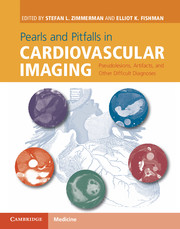 Pearls and Pitfalls in Cardiovascular Imaging
Pearls and Pitfalls in Cardiovascular Imaging from Section 7 - Acute aorta and aortic aneurysms
Published online by Cambridge University Press: 05 June 2015
Imaging description
The diagnosis of aortic aneurysm rupture is straightforward on CT. Both precontrast and post-contrast acquisitions will demonstrate disruption of the aneurysm wall with perianeurysm hemorrhage extending into the retroperitoneum and possibly the peritoneal cavity. Prior to frank rupture, certain findings on CT may reflect instability of an intact abdominal aortic aneurysm or contained rupture. Instability indicators include intramural or intrathrombus hemorrhage (“hyperattenuating crescent” sign), perianeurysmal hemorrhage, and disruption of previously continuous aortic wall calcification. The hyperattenuating crescent sign indicates hemorrhage within aneurysm thrombus or the aneurysm wall, and can be recognized by high-attenuation material within the plaque or the wall (Figure 62.1). A small perianeurysm hematoma may be identified prior to frank rupture, suggesting contained rupture (Figure 62.2).
Contained rupture may also manifest as a new focal outpouching of the aortic wall or the “draped aorta” sign (Figures 62.3, 62.4). The latter appears as loss of the fat plane between the posterior wall of the aortic aneurysm and the adjacent vertebral body, and psoas muscle on axial images, and a focal posterior outpouching on sagittal MPRs. Cognizance of these findings is essential so that the interpreting radiologist can alert the vascular surgeon to guide intervention.
Careful assessment for aneurysm enlargement is equally important. A size threshold of 5.5cm has been defined for repair of an abdominal aortic aneurysm. The typical rate of aneurysm enlargement is 1–4mm/year. Rapid aneurysm enlargement is defined as > 6mm in 6 months or >1cm in one year. Measurement should be tailored to the configuration of the aneurysm and performed on current and prior CT examinations for optimal reproducibility. If available, comparison to older studies is recommended, because changes in size may be more apparent than comparison to recent studies alone.
Importance
Imaging signs that suggest a high risk of rupture are important to recognize to prompt treatment before the occurrence of acute aortic rupture, which has a very high mortality rate.
To save this book to your Kindle, first ensure [email protected] is added to your Approved Personal Document E-mail List under your Personal Document Settings on the Manage Your Content and Devices page of your Amazon account. Then enter the ‘name’ part of your Kindle email address below. Find out more about saving to your Kindle.
Note you can select to save to either the @free.kindle.com or @kindle.com variations. ‘@free.kindle.com’ emails are free but can only be saved to your device when it is connected to wi-fi. ‘@kindle.com’ emails can be delivered even when you are not connected to wi-fi, but note that service fees apply.
Find out more about the Kindle Personal Document Service.
To save content items to your account, please confirm that you agree to abide by our usage policies. If this is the first time you use this feature, you will be asked to authorise Cambridge Core to connect with your account. Find out more about saving content to Dropbox.
To save content items to your account, please confirm that you agree to abide by our usage policies. If this is the first time you use this feature, you will be asked to authorise Cambridge Core to connect with your account. Find out more about saving content to Google Drive.